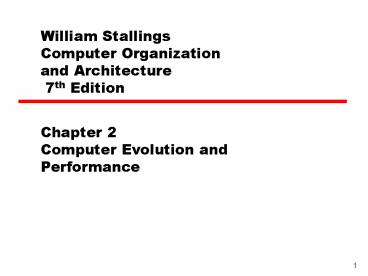William Stallings Computer Organization and Architecture 7th Edition PowerPoint PPT Presentation
1 / 23
Title: William Stallings Computer Organization and Architecture 7th Edition
1
William Stallings Computer Organization and
Architecture 7th Edition
- Chapter 2Computer Evolution and Performance
2
ENIAC - background
- Electronic Numerical Integrator And Computer
- Eckert and Mauchly
- University of Pennsylvania
- Trajectory tables for weapons
- Started 1943
- Finished 1946
- Too late for war effort
- Used until 1955
3
ENIAC - details
- Decimal (not binary)
- 20 accumulators of 10 digits
- Programmed manually by switches
- 18,000 vacuum tubes
- 30 tons
- 15,000 square feet
- 140 kW power consumption
- 5,000 additions per second
4
von Neumann/Turing
- Stored Program concept
- Main memory storing programs and data
- ALU operating on binary data
- Control unit interpreting instructions from
memory and executing - Input and output equipment operated by control
unit - Princeton Institute for Advanced Studies
- IAS
- Completed 1952
5
Structure of von Neumann machine
6
Structure of IAS detailIBM
7
Generations of Computer
- Vacuum tube - 1946-1957
- Transistor - 1958-1964
- Small scale integration - 1965 on
- Up to 100 devices on a chip
- Medium scale integration - to 1971
- 100-3,000 devices on a chip
- Large scale integration - 1971-1977
- 3,000 - 100,000 devices on a chip
- Very large scale integration - 1978 -1991
- 100,000 - 100,000,000 devices on a chip
- Ultra large scale integration 1991 -
- Over 100,000,000 devices on a chip
8
Moores Law
- Increased density of components on chip
- Gordon Moore co-founder of Intel
- Number of transistors on a chip will double every
year - Since 1970s development has slowed a little
- Number of transistors doubles every 18 months
- Cost of a chip has remained almost unchanged
- Higher packing density means shorter electrical
paths, giving higher performance - Smaller size gives increased flexibility
- Reduced power and cooling requirements
- Fewer interconnections increases reliability
9
Growth in CPU Transistor CountIntel
10
Speeding it up
- Pipelining
- On board cache
- On board L1 L2 cache
- Branch prediction
- Data flow analysis
- Speculative execution
11
Performance Balance
- Processor speed increased
- Memory capacity increased
- Memory speed lags behind processor speed
12
Logic and Memory Performance Gap
13
Solutions
- Increase number of bits retrieved at one time
- Make DRAM wider rather than deeper
- Change DRAM interface
- Cache
- Reduce frequency of memory access
- More complex cache and cache on chip
- Increase interconnection bandwidth
- High speed buses
- Hierarchy of buses
14
I/O Devices
- Peripherals with intensive I/O demands
- Large data throughput demands
- Processors can handle this
- Problem moving data
- Solutions
- Caching
- Buffering
- Higher-speed interconnection buses
- More elaborate bus structures
- Multiple-processor configurations
15
Typical I/O Device Data Rates
16
Key is Balance
- Processor components
- Main memory
- I/O devices
- Interconnection structures
17
Improvements in Chip Organization and Architecture
- Increase hardware speed of processor
- Fundamentally due to shrinking logic gate size
- More gates, packed more tightly, increasing clock
rate - Propagation time for signals reduced
- Increase size and speed of caches
- Dedicating part of processor chip
- Cache access times drop significantly
- Change processor organization and architecture
- Increase effective speed of execution
- Parallelism
18
Problems with Clock Speed and Logic Density
- Power
- Power density increases with density of logic and
clock speed - Dissipating heat
- RC delay
- Speed at which electrons flow limited by
resistance and capacitance of metal wires
connecting them - Delay increases as RC product increases
- Wire interconnects thinner, increasing resistance
- Wires closer together, increasing capacitance
- Memory latency
- Memory speeds lag processor speeds
- Solution
- More emphasis on organizational and architectural
approaches
19
Intel Microprocessor Performance
20
Increased Cache Capacity
- Typically two or three levels of cache between
processor and main memory - Chip density increased
- More cache memory on chip
- Faster cache access
- Pentium chip devoted about 10 of chip area to
cache - Pentium 4 devotes about 50
21
More Complex Execution Logic
- Enable parallel execution of instructions
- Pipeline works like assembly line
- Different stages of execution of different
instructions at same time along pipeline - Superscalar allows multiple pipelines within
single processor - Instructions that do not depend on one another
can be executed in parallel
22
Diminishing Returns
- Internal organization of processors complex
- Can get a great deal of parallelism
- Further significant increases likely to be
relatively modest - Benefits from cache are reaching limit
- Increasing clock rate runs into power dissipation
problem - Some fundamental physical limits are being
reached
23
New Approach Multiple Cores
- Multiple processors on single chip
- Large shared cache
- Within a processor, increase in performance
proportional to square root of increase in
complexity - If software can use multiple processors, doubling
number of processors almost doubles performance - So, use two simpler processors on the chip rather
than one more complex processor - With two processors, larger caches are justified
- Power consumption of memory logic less than
processing logic - Example IBM POWER4
- Two cores based on PowerPC

